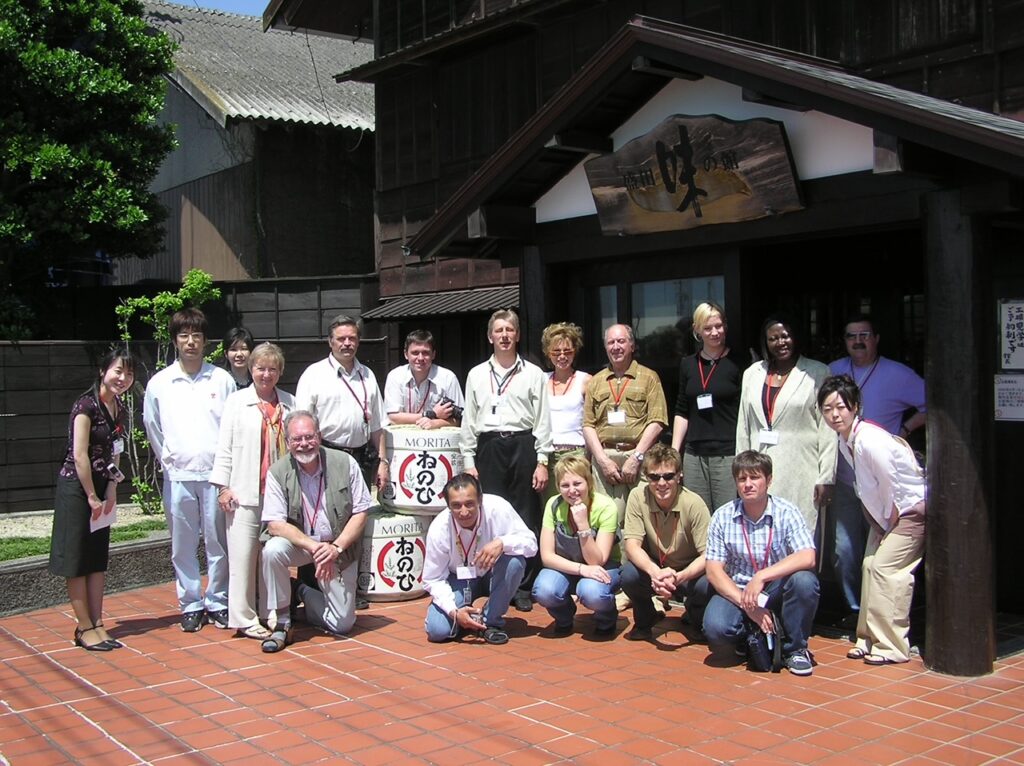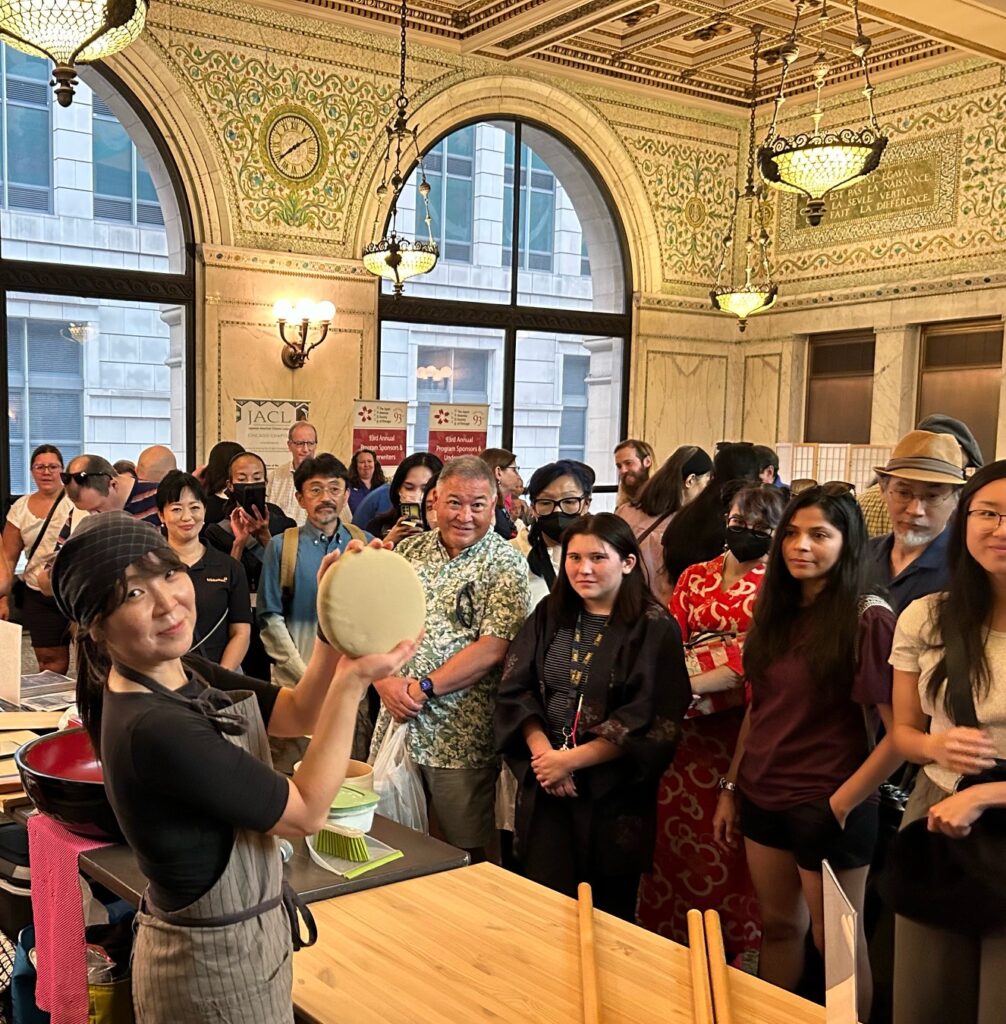TSUNAGU: To Connect: Whether it is connecting employers to job seekers or bringing different cultures together, we at Activ8 value the bridge-builders who make our world a better place every day. Our new series, TSUNAGU, will feature inspirational people who connect North America and Japan through business, education, art, culture and more.
Mariko Kallister: Soba-Making Master, Human Resource Professional

Mariko Kallister is a master of soba-making who came to her craft through an intense personal journey. A native of the Aichi Prefecture in Japan, Mariko now lives in Chicago, and by day is a human resources professional at a Japanese American corporation, but she spends many weekends at the city’s premier Japanese restaurants and bars demonstrating the process of soba-making as she educates her audiences about the Japanese traditions associated with these special noodles.
Encountering Japanese Sake
All her life, Mariko has been the type of person who gets into something, then immerses herself in that endeavor. She was born and raised in Aichi Prefecture, which is known as Japan’s manufacturing hub. Early in her career, Mariko worked as an international event staff member introducing Japanese traditions and industry to guests from around the world. At the 2005 Aichi EXPO, also known as a World’s Fair, Mariko took foreign participants to sake breweries and found that she was even more fascinated by the fresh sake than they were. She became passionate about learning about sake, and rapidly acquired a great deal of knowledge about how sake is brewed and about the different flavors in each type. One of the sake brands that most impressed her was Dassai from the Asahi Shuzo Brewery in Yamaguchi Prefecture.
“Dassai’s fruity aroma was so impactful,” Mariko said. “It was like wine.” This experience had a huge impact on her life, which actually led her to learn how to make sake herself later in her life.
 (photo) Mariko led the Expo Pavilion staff to the “Nenohi” Sake Brewery.
(photo) Mariko led the Expo Pavilion staff to the “Nenohi” Sake Brewery.
Life Change
Mariko met her future husband, an American, at work in Japan, and they eventually came to Chicago to start a new life. Mariko was excited at first, but then they encountered significant life challenges. The couple lost their jobs due to the global financial crisis, and Mariko, being a mother of a newborn, could not go to work right away. She felt uneasy and stuck.
“How could I help financially?” she wondered. After contemplating the situation, she thought of the sake brewery she learned about at a sake event, and began to dream of starting a sake brewery in America so that people here could experience the same fresh quality. One day at around the same time, Mariko heard about Master Takahashi, aka “the God of Soba Noodles,” from her mother. Historically, since the Edo period, soba noodles have had a deep connection with sake. Sake was always on the menu at soba noodle restaurants, and it was served while the customers were waiting for the soba noodles to be prepared.
Mariko hoped Master Takahashi would teach her to make soba noodles that pair well with sake. She called the Master and asked him to teach her how to make soba noodles. With the master’s permission, Mariko flew back to Japan and went to the mountains in Hiroshima to learn soba-making from the soba master. Then, Mariko moved to the rural Yamaguchi Prefecture with her husband and child, and took jobs for a year as brewing assistants at Asahi Shuzo, the Dassai brewery.
 (photo) Mariko learned how to make soba from Master Takahashi in the mountains of Hiroshima.
(photo) Mariko learned how to make soba from Master Takahashi in the mountains of Hiroshima.
Over the obstacles; Into the world of soba-making
With the completion of these training periods, Mariko’s family returned to the U.S. with their dream of opening a sake brewery pub in Chicago. Handmade soba noodles would be served together with the fresh sake. But then, the couple’s marriage ended, and Mariko’s dream was shelved. With no vision for a future career and as a newly single mom, Mariko wasn’t sure about her next step. She had no immediate family around, and was really worried she wouldn’t be able to provide all that her son needed. She stood strong, however, and took on a corporate job. Her life got quite busy with home and work. She kept making soba noodles, though, just for fun and relaxation. She enjoyed the quiet, meditative moment in making soba, and discovered it gave her genuine peace of mind.
A few years later, she was asked to demonstrate making soba at a private party. The event was very successful, and her performances gained popularity. Soba-making opened doors to Mariko and provided her with many connections. She was invited to more events, and got rave reviews from her audiences as well as media. “I was fortunate with the timing,” Mariko said. “Now the world is more aware of healthy food. The audience is more mature and can enjoy the delicate aroma of buckwheat. If it were 10 years ago, things would not be like this.”
Mariko thinks Chicago is a great place to introduce Japanese culture as it is not yet as well known as in New York or California. She currently has soba-making events every month.
 (photo) Soba-making event at TenGoku Aburiya in Chicago’s WEST LOOP.
(photo) Soba-making event at TenGoku Aburiya in Chicago’s WEST LOOP.
Special Soba
Mariko makes soba noodles with a traditional “80/20 ratio” of buckwheat flour (80%) to wheat flour (20%). This ratio allows people to enjoy the noodles’ great flavor as well as their great smoothness – “nodogoshi,” which means “good swallowing feeling.” Mariko used to import the buckwheat from Japan, but she now orders it from New York, which lets her serve fresh soba noodles as she can use the freshly ground buckwheat. Buckwheat contains a large amount of nutrients. Since the Edo period, it has been widely believed that soba noodles are beneficial to one’s health, and pairing soba with sake became popular at restaurants specializing in soba.
 (photo: Evenly sliced soba noodles are truly a work of art.
(photo: Evenly sliced soba noodles are truly a work of art.
Demonstrating Soba-making
Mariko’s performances attract both Japanese and non-Japanese people: Japanese are thrilled to learn about one of the classic tastes of home while non-Japanese audiences enjoy learning about a new culture with new flavors.
All the tools Mariko uses have a visual impact: a uniquely shaped soba cutting knife, an extra-long cutting board, three long rolling pins, and a huge kneading bowl. As she skillfully uses her tools, Mariko speaks into her hands-free microphone, narrating how she makes soba noodles, adding comments along the way. Soba-making requires a lot of physical strength, not just in the arms, but in the whole body. Mariko thinks that her training for running marathons actually helps soba-making as well.
Weather is another important aspect in soba-making; the amount of water used in the dough depends on the humidity in the air that day. While kneading the dough, Mariko senses with her fingers if more water is needed. The whole process from preparing the dough to cutting it has to be done efficiently within 50 minutes to prevent the surface from getting dry. During the performance, Mariko tells the audience the important steps and the history of soba noodles, and she greatly enjoys answering audience questions. The audience loves smelling the fresh aroma of the buckwheat flour, listening to the rhythmic sound of cutting the dough, and, of course, eating the freshly made soba. Mariko likes to make sure her performances fully delight all five of her audience’s senses.
 (photo)Saba-making demonstration at the Japan Festival 2023
(photo)Saba-making demonstration at the Japan Festival 2023
Career Advice
Mariko has paved her own way in life, and we asked if she had any advice for those who feel unsure about their career path.
“My life had many setbacks,” said Mariko. “I had little control over those challenges. However, those obstacles actually took me to new opportunities.”
Mariko thinks of Japanese people are hardworking and sincere, qualities that are well-appreciated in American society also, and she encourages other people to be confident in their good qualities, too. Mariko now loves demonstrating soba-making in front of people, but when she was little, she used to be rather shy and preferred to spend her time reading books. “We all can change ourselves,” said Mariko with a smile.
Future Vision
Mariko loves connecting people through international exchanges both in her cooperate work and in soba-making. As a human resource specialist, she provides training for employees and helps communication between the head office in Japan and the Chicago office. In soba-making, Mariko sees the reaction from the audience immediately. She appreciates all of these different modes of communication all the more after the pandemic.
She has big dreams for her soba-making in the near future. Mariko is hoping to expand the number of those who love soba by introducing noodles in unique styles and new combinations with other dishes. She also envisions opening a soba-making class for families to enjoy.
Rich in nutrients, soba is a great match for today’s health needs, and as Americans grow more health conscious, it will surely be a greater part of our diet. Through Mariko’s skill and efforts, the benefits of this Japanese traditional food are indeed becoming more widely known. We hope Mariko continues to flourish in all her endeavors, and look forward to see what’s next.
Website: sakesobamariko.com
Instagram: sake_soba_mariko
Future event:
- Japan Festival @ Chicago/Millennium Park (Sun. June 16, 11AM~5PM)
- Tachinomi & Soba Demo @ Chicago/Dovetail Brewery (Sun. June 30, 2PM~)

